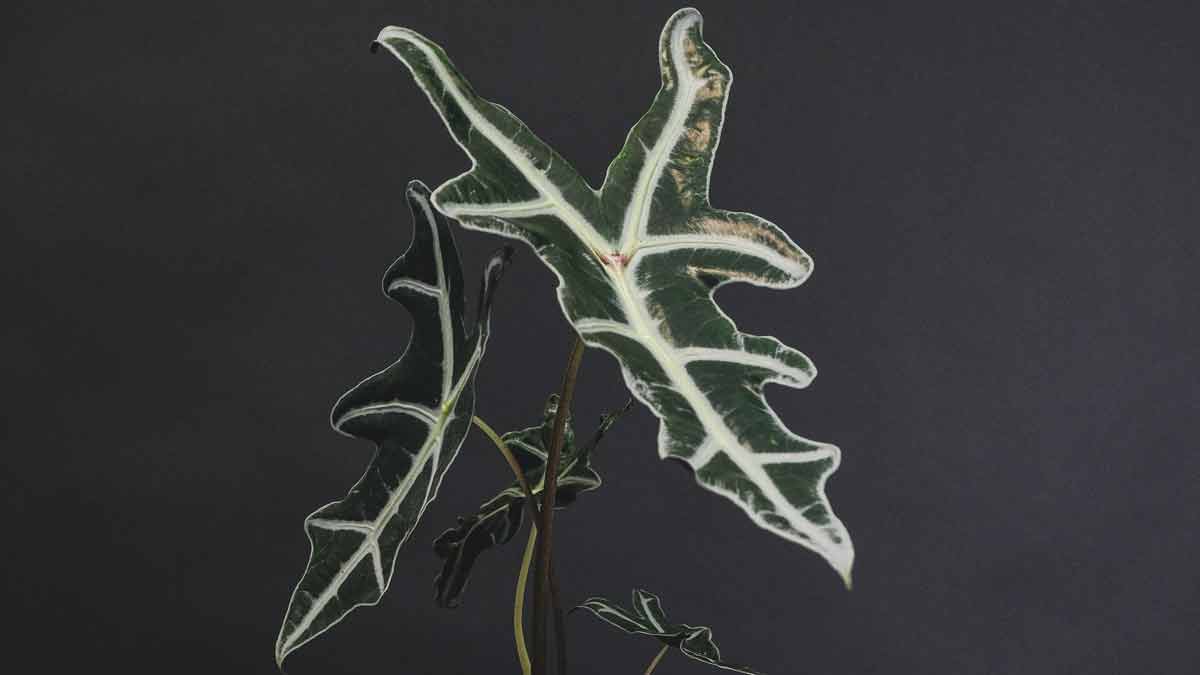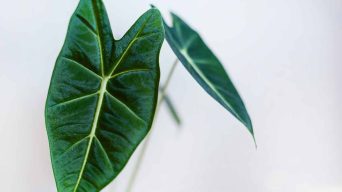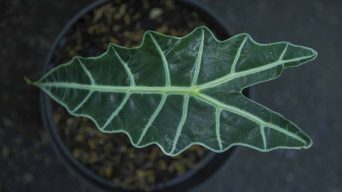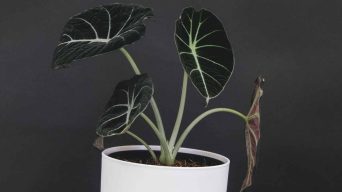Brown leaves on Alocasia plants can be caused by factors such as leaf burn, low humidity, underwatering, fertilizer burn, pests, direct sunlight exposure, insufficient light, or diseases. To prevent, maintain proper watering, provide sufficient light and humidity, avoid overfertilization, and monitor for pests.
Alocasia is a genus of flowering plants in the family Araceae, native to Southeast Asia and Australasia. Due to their large, colorful leaves, many species are grown as ornamental houseplants.
However, alocasia plants are notoriously finicky, and their leaves often turn brown for various reasons.
If you’re noticing your alocasia leaves turning brown, don’t despair! This article will discuss the 11 most common causes of alocasia leaf browning and how you can fix it.
Why Do Alocasia Leaves Turn Brown and What Can You Do About It?
There are a few reasons why alocasia leaves might turn brown. Here are the 11 most common causes and what you can do to fix them.
Too Much Sunlight
An alocasia plant getting too much direct sunlight will often develop brown spots on its leaves. This is because the sun’s rays burn the leaves, causing them to turn brown and dry out.
There are some signs that your alocasia plant is getting too much sunlight, such as:
- The leaves are starting to turn brown or yellow around the edges.
- The leaves are drying out and becoming crispy.
- The leaves are dropping off the plant.
How To Fix a Browning Alocasia Caused by Sunlight
If you think your alocasia brown leaves are caused by too much sunlight, the first thing you should do is move it to a spot that gets less direct light. A west- or east-facing window would be ideal.
You can also place a sheer curtain over the window to diffuse the light. Ensure that the alocasia still gets enough light to prevent it from going into dormancy.
Not Enough Light
While too much sunlight can cause alocasia leaves to turn brown, not enough sunlight can also be a problem. Alocasia plants need bright indirect light to thrive; not getting enough light can cause the leaves to turn brown.
Some signs that your alocasia plant is not getting enough light are:
- The leaves are starting to turn yellow.
- The leaves are small and stunted.
- The plant is leggy (stretched out).
How To Fix a Browning Alocasia Caused by Lack of Light
If you think lack of light causes alocasia leaf browning, the first thing you should do is move it to a spot that gets more light. An east- or west-facing window would be ideal.
You can also use grow lights to give your alocasia the extra light it needs. Follow the manufacturer’s instructions on how long and often to use the grow lights.
Too Much Heat
Alocasia plants are native to tropical climates and prefer warm temperatures. However, the plant leaves can turn brown if the temperature gets too hot.
Some signs that your alocasia plant is getting too much heat are:
- The leaves are starting to turn brown or yellow around the edges.
- The leaves are wilting.
- The brown leaf tip is curling.
How To Fix a Browning Alocasia Caused by Heat
If you think your alocasia brown leaves are caused by too much heat, the first thing you should do is move it to a cooler spot. An air-conditioned room or a north-facing window would be ideal.
Also, mist the leaves with water to help cool them down. Just ensure that the alocasia is not in direct sunlight, which can cause the leaves to burn.
Too Much Water
While alocasia plants need to be kept moist, too much water can cause the leaves to turn brown. This is because the roots are not getting enough oxygen and are starting to rot.
Some signs that your alocasia plant is getting too much water are:
- The leaves are starting to turn yellow or brown.
- The leaves are wilting.
- The leaves are soft and mushy.
- The roots are black and mushy.
How To Fix a Browning Alocasia Caused by Overwatering
If you think your alocasia browning is caused by overwatering, you should stop watering it for a few days to allow the soil to dry out. Once the soil is dry, start watering the alocasia again.
Also, repot the alocasia into a pot with drainage holes to allow the excess water to drain out. Just make sure to use a well-draining potting soil mix.
Too Little Water
While alocasia plants need to be kept moist, not watering them enough can also cause the leaves to turn brown. This is because the plant needs more water to support its growth.
Some signs that your alocasia plant is not getting enough water are:
- The leaves are starting to turn yellow or brown.
- The leaves are wilting.
- The leaves are dry and crispy.
- The leaves are drooping.
How To Fix a Browning Alocasia Caused by Underwatering
If you think your alocasia’s browning is caused by underwatering, you should first water it thoroughly. Be sure to water the alocasia until the water comes out of the drainage holes in the bottom of the pot.
The best way to water an alocasia is to soak the pot in a sink or tub of water for 15-30 minutes. This allows the roots to absorb as much water as they need.
Too Little Humidity
Alocasia plants prefer high humidity conditions similar to their native tropical climates. If the air is too dry, the leaves can turn brown.
Some signs that your alocasia plant is not getting enough humidity are:
- The leaves are starting to turn brown or yellow around the edges.
- The leaves are wilting.
- The brown tips are curling.
How To Fix a Browning Alocasia Caused by Low Humidity
If you think your alocasia’s browning is caused by low humidity, you should first mist the leaves with water daily.
You can also place the alocasia on a pebble tray. Place a layer of pebbles in a tray and fill it with water. Place the alocasia pot on top of the pebbles so that the pot is not sitting in the water. The water’s evaporation will help increase the alocasia’s humidity.
Pest Infestation
Alocasia plants are susceptible to pests such as aphids, mealybugs, and scale. These pests can suck the sap out of the leaves, damaging them and causing them to turn brown.
Some signs that your alocasia plant has a pest infestation are:
- The leaves are covered in tiny bugs.
- The leaves are sticky or have a weird smell.
- The leaves are wilting.
- The leaves are starting to turn yellow or brown.
How To Fix a Browning Alocasia Caused by Pests
If you think pests cause your alocasia’s browning, you should inspect the plant carefully for signs of pests. If you see any pests on the plant, you can try to remove them by hand. Use a cotton swab dipped in rubbing alcohol to kill the pests.
You can also try using natural pest control such as neem oil or insecticidal soap. This will help to kill the pests and prevent them from coming back.
Fungal Infection
Alocasia plants are susceptible to fungal infections such as root rot and powdery mildew. These infections can damage the plant and cause leaf browning.
Some signs that your alocasia plant has a fungal infection are:
- The leaves are wilting.
- The leaves are yellowing or browning.
- The leaves are covered in a white powdery substance.
- The stems are soft or mushy.
- The plant is rotting at the roots.
How To Fix a Browning Alocasia Caused by Fungal Infection
If you think a fungal infection causes your alocasia’s browning, you should first remove any affected leaves from the plant. These leaves should be disposed of so they don’t spread the infection to other plants.
You can also use a fungicide to treat the plant. You can use a chemical or natural fungicide such as baking soda or neem oil.
Nutrient Deficiency
Alocasia plants need a balance of nutrients to stay healthy. If the plant is not getting enough nutrients, it can cause the leaves to turn brown. The most common nutrient deficiencies in alocasia plants are iron and magnesium.
Some signs that your alocasia plant has a nutrient deficiency are:
- The leaves are losing their green color and turning yellow or brown.
- The leaves are wilting.
- The leaves are small or stunted.
- The plant is not growing as quickly as it should be.
How To Fix a Browning Alocasia Caused by Nutrient Deficiency
If you think a nutrient deficiency causes your alocasia’s browning, you first should fertilize the plant. Use a balanced fertilizer containing all the nutrients alocasia plants need. You can also try using a fertilizer specific to alocasia plants.
You can also give the plant a nutrient boost by adding compost or organic matter to the soil. This will help to increase the nutrients in the potting soil and help the alocasia to recover.
Overfertilization
Alocasia plants are sensitive to fertilizer and can be quickly burned by it. If the plant is getting too much fertilizer, it can cause the leaves to turn brown.
The salts in the fertilizer can build up in the soil, making it difficult for the plant to absorb water. This will cause the leaves to turn brown and eventually die.
Some signs that your alocasia plant has been overfertilized are:
- Brown or yellow leaves
- Stunted growth
- Distorted leaves
- Slow growth
- The plant should be growing more quickly.
How To Fix a Browning Alocasia Caused by Overfertilization
If you think your alocasia’s browning is caused by overfertilization, you should first flush the soil with water. This will help to remove some of the excess fertilizer from the soil.
You can also try leaching the soil. This will help to remove even more of the fertilizer from the soil. To do this, water the plant deeply and then let the water drain out completely. Repeat this process a few times.
Water Quality
The quality of the water you use to water your alocasia plant can also affect the leaves. If the water is too hard or has a high mineral content, it can cause the leaves to turn brown.
Some signs that the water you are using is causing the alocasia’s leaves to turn brown are:
- The leaves are yellowing or browning.
- The leaves have spots or streaks.
- The edges of the leaves are turning brown.
How To Fix a Browning Alocasia Caused by Water Quality
If the water quality is the problem, the best solution is to use distilled water or rainwater to water your plant. You can also let the tap water sit out overnight so the minerals can settle before using it on your alocasia.
Final Thoughts
There are many reasons why alocasia leaves turn brown. The most common causes are too much or too little water, too much or too little sun, pests, diseases, and nutrient deficiencies. You can fix most of these problems by changing how you care for your alocasia plant.
Alocasia plant care can be tricky, but you can grow a healthy and beautiful alocasia plant with patience and care. Keep an eye on the leaves and act quickly if you see any browning.







